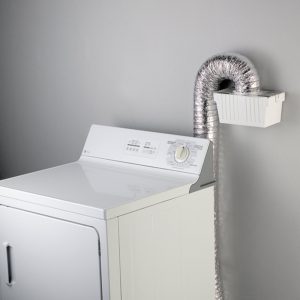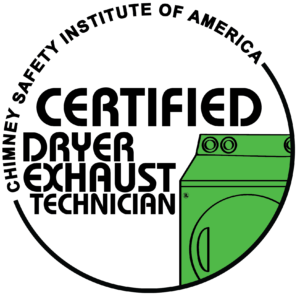 As homes are remodeled and laundry rooms are created where there wasn’t one before, contractors have had to get very creative with how to vent the dryer from the laundry room to the exterior of the home as required by building code. Sometimes it’s not possible to vent to the outside. In this case, contractors may recommend an “Indoor Dryer Vent Kit.” These kits can be easily found in hardware stores, big box stores and online.
As homes are remodeled and laundry rooms are created where there wasn’t one before, contractors have had to get very creative with how to vent the dryer from the laundry room to the exterior of the home as required by building code. Sometimes it’s not possible to vent to the outside. In this case, contractors may recommend an “Indoor Dryer Vent Kit.” These kits can be easily found in hardware stores, big box stores and online.
The manufacturers of these products claim to solve the problem of venting a dryer to the exterior of the home. They also claim that Indoor Dryer Vent Kits are ideal for apartments, condominiums and RV’s.
However there are some down sides. Here are some things you may want to take into consideration if you use this product.
How do these Indoor Dryer Vent Kits work?
The flexible dryer exhaust hose is simply routed from the back of the dryer into the reservoir of these Indoor Dryer Vent Kits. Water is placed inside the reservoir. The theory to this product is that the water acts as a filter and catches the lint. The homeowner is supposed to change out the water after every load.
Eight problem with Indoor Dryer Vent Kits

1) Just because a product is sold in a big box store doesn’t mean that it meets building code. In fact, the 2016 California Mechanical code 504.4 specifically says: “Clothes dryer exhaust ducts shall (meaning required to) terminate to the outside of the building.” Many states have this same code. This means that Indoor Dryer Vent Kits are against code in California and in fact, in most other states. Before purchasing, check your state and local mechanical codes to determine if these products are legal to use in your area.
2) For every load of laundry you dry, you are venting up to a gallon of water in condensation from your dryer. This will create a sauna in your laundry room. The water reservoir for an Indoor Dryer Vent Kit doesn’t prevent that moisture from exhausting into that room. In fact, the humidity in that room can get so bad that your walls and ceiling will be dripping with moisture. Eventually the paint will bubble and peel. The extra moisture will also ruin wood cabinets in the room. Opening up a door or window in the laundry room may not be enough to solve the excessive moisture issue.
3) This extra humidity and moisture will create mold problems in your home since the moisture is getting into the drywall and wood cabinets.
4) Lint can pass through the Indoor Dryer Vent Kit’s reservoir without going into the reservoir water which means the lint will coat your laundry room and house with a fine layer of lint. The lint doesn’t necessarily get trapped inside that water reservoir. When lint accumulates inside a room, the buildup can create a fire hazard. And of course, it creates a mess too.
5) There have been documented complaints that the fine particulates of lint that escape from the reservoir can cause the smoke detector to go off.
6) Even more dangerous, the manufacturers of these Indoor Dryer Vent Lint Kits warn homeowners not to use this device with gas dryers. Many homeowners either don’t realize this hazard or may not even know if they have an electric dryer or gas dryer. Venting your gas dryer inside a home is like running your car in the garage with the garage door closed. This could prove deadly.
7) The hassle factor is huge. The manufacturers of the Indoor Dryer Vent Kits recommend to change the water inside the reservoir after every load. In reality, when we go to a house that has been using this set-up, the water hasn’t been changed for weeks or months since it’s such a nuisance to deal with.
8) Since most of us now live in airtight homes, the lint particulates migrate into the entire living area. It is then in the air you breathe. For people who have asthma or allergies, this can be a major health hazard. Why take the risk?
Solutions to dryer vent problems
If the system is routed properly, many times the very simple fix is to clean the existing dryer vent system that may have become plugged with use. Most people don’t realize that chimney sweeps do dryer vent cleaning. They have the proper specialized dryer vent cleaning equipment that will scrub through the multiple 90 degree bends that most dryer vent systems have.
 Here are the signs that you need your dryer vent cleaned.
Here are the signs that you need your dryer vent cleaned.
To find a qualified Dryer Exhaust Technician in your area, go to the Chimney Safety Institute of America website and look for the technicians with the Certified Dryer Exhaust Technician logo.
In cases where the dryer vent system is disconnected or not routed properly, many times a contractor can install a dryer vent system for an affordable price.
The dryer is one of the most dangerous appliances in your home. Here are some easy tips to keep you safe while you’re using your dryer.
Don’t depend on the easy fix to take care of your dryer vent problem. Easy is not necessarily better.

would a Bettervent box be a good option because the exiting vent system is 45′ with 3 elbows and I can’t see any air movement to the outside and clothes take along to dry. The dryer is electric
Thank you
The Bettervent Box is just a variation of other indoor dryer vent kits. Perhaps the Bettervent Box is a little bit easier because you don’t have the inconvenience of cleaning out the water receptacle after every few loads from other indoor dryer vent kits but you’re still going to get too much humidity in that room. Remember, for each load of laundry you dry, you’re venting out a half a gallon of moisture and condensation.
In looking at the reviews on Amazon for this product, many of the reviews said that it was like a sauna in the room.
In addition, the California Mechanical Code explicitly states that the vent must terminate to the outside of the building. Therefore the Bettervent product is not to code. You didn’t say which state you live in. If it’s not California, then you should research if this device meets building code in your state.
By the way, the code also says that your dryer run should not be any longer than 25 feet and for every 90 degree bend, you reduce that by 5 feet. Your dryer vent system isn’t to code either which explains why you’re not getting any air pressure at the exhaust termination and why your clothes are taking too long to dry.
Great article. I moved into a temp living apartment with a bettervent. Had never used one before but after the first run of laundry I couldn’t believe how much moisture was in the room! Water running down the walls and water heater lines (it’s in the same room). And the door and door jam wood expanded so much after just one load the door became very tight and difficult to open. I googled to see if this was possibly a faulty install or filter. Nope! These vents aren’t a solution for regular laundry use.
You bring up a GREAT POINT. But even more important, if the dryer vent system is plugged to the point where moisture is backing into the room, if the dryer is a gas dryer, then gas is also backing into the room which is EXTREMELY dangerous! Good for you that you recognized the problem. So many people ignore the issue.
I just moved into an apartment told I have washer dryer hookup. That was a requirement when looking for an apartment. Well there is no vent to outside. I was told I got a washer dryer hookup. I will need to buy a vent box. Needless to say I am furious. I did buy and it soaked everything in room. I am on a year lease. Is what they did legal?
I hang my clothes on a clothes line in the summer but I live in Minnesota so that is not possible in the winter. As I rent my home my landlord will not allow me to vent to the outside so I have a water filter type dryer vent and it works fine if you do a few thing’s. #1: only do one or two loads per day and space them out at least 4 hour’s apart. #2: use a second extraction cycle before placing clothing in the dryer. #3: run a fan in the laundry room during the drying period and for an hour or so after to stir up the air so it is less likely to condense on anything. #4: don’t place the filter unit in the proximity of wood cabinets unless they are finished with spar varnish or another waterproof finish. #5: If you live in a very humid location I would not use an indoor dryer vent. Minnesota can be very humid in the summer and as my air conditioning bill is quite high to start there is no need to compound the problem. If you can’t hang your clothing on a line take them to a laundromat to dry them.